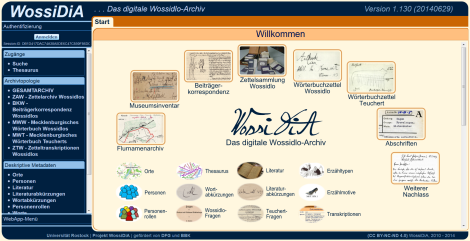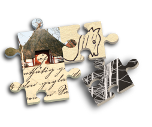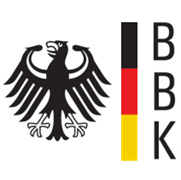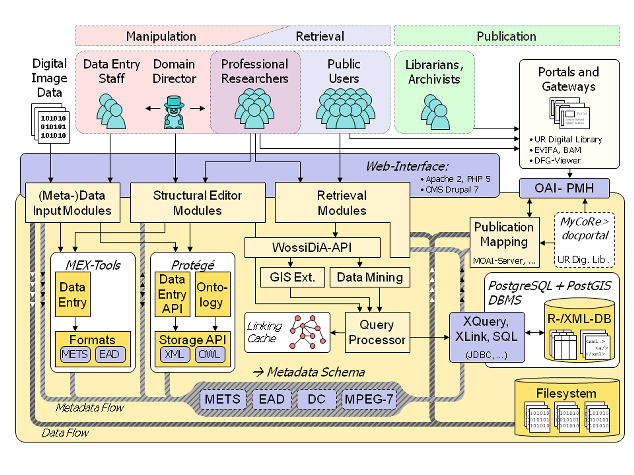The WossiDiA Project
Deutsche Version siehe Das WossiDiA-Projekt
These pages provide background information on contents, aims, and emergence context of the WossiDiA project. Click the image below to proceed to the digital Wossidlo archive (German only). Login is not required.
Within the digital archive you can find very basic usage guides. A more detailed guide on readability and archival relationships may be found here (German only).
Please note the following advice: The digital Wossidlo archive is available since only a few months ago. It is a pilot project and therefore not fully matured yet. It is continuously revised, extended, and optimized. Please understand that we initially recommend the Firefox web browser for using the digital archive. Other web browsers and especially those on mobile devices have not yet been sufficiently tested with WossiDiA; that's why we discourage you from using them.
WossiDiA is the digital archive information sytem, which helps us to transfer more than two point five million paper notes and correspondence documents, the actual estate of Mecklenburg’s "first" ethnographer Richard Wossidlo (1859 - 1939), into an electronic online archive.
Richard Wossidlo is considered the founder of Mecklenburgian ethnology (Volkskunde), as one of the fathers of German-speaking Ethnology / Cultural Anthropology, and as one of the most important field researchers of European Ethnology. He also formed the concept of ethnographic museum in his area and collected oral data for the later published "Mecklenburgisches Wörterbuch" (Dictionary of Eastern Low German Language, precisely of the Mecklenburgian dialect).
Inhaltsverzeichnis
Projectpartner
The project is carried out at the University of Rostock as an interdisciplinary cooperation between the Department for European Ethnology/Cultural Anthropology and the Department for Computer Science.
- Dr. phil. Christoph Schmitt
- Philosophische Fakultät
- Universität Rostock
- Am Reifergraben 4
- 18055 Rostock
- Tel.: +49 (0) 381 498 1051
- E-Mail: christoph.schmitt@uni-rostock.de
- Dr.-Ing. Holger Meyer
- Universität Rostock
- Albert-Einstein-Str. 21
- 18059 Rostock
- Tel.: +49 (0)381 - 498 7590
- Fax: +49 (0)381 - 498 7592
- E-Mail: hme@informatik.uni-rostock.de
Sub-Contractor
- Wolfener Str. 36
- 12681 Berlin
- Tel.: +49 (0)30 93554800
- Fax: +49 (0)30 93554802
- E-Mail: mail@mikrounivers.de
Förderung
- Kennedyallee 40
- 53175 Bonn
- E-mail: postmaster@dfg.de
- Provinzialstraße 93
- 53127 Bonn
- E-mail: poststelle@bbk.bund.de
Matters of the project
Goals
This subject deals with the goals of the project in two sub divisions:
The project can be explained with the following sketch:
In short, the advantages of the system are:
- Performance
- Protection of the original notes
- Detecting interrelations
Migrating a handwritten archive into an online resource
Whilst archives, so far, limit themselves to presenting actual stocks or less extensive documents online, this project runs a pioneer-like attempt to provide a whole and extensive handwritten archive online. Most up-to-date computer-techniques and modern analysis serve in order to edit the 2.3 million digital pictures which are planned to be a long-lasting open source.
Interlinking a body of acquired knowledge
Richard Wossidlo’s estate as a researcher in the field ranks among the most relevant folk-archives in Europe, bearing no taboos in terms of the amplitude of subjects. It’s density, coherence, systematic and hand-written notation represent an early attempt of establishing an interlinked database – a challenge for computer scientists. To visibly unfold the interlinking within different corpora and integrating further corpora opens up new dimensions and synergies for science which is essential to this project. Systematically ordered collections of paper slips are provided, on the one hand, of an ethnographer and the evaluated correspondence with his collection helpers. The character of this stock is, on the one hand, primarily regional-encyclopaedic and holds evaluated data of field research as well as then already published sources from different periodicals, which were hardly accessible.
On the other hand, the online collection is going to be supplemented by excerpts of trans-regional ethnologic literature (approx. 500.000 to 600.000 digital images).
Virtual platform for ethnologic estates
The estate is assorted by a highly differentiated thesaurus – which is re-edited in terms of catchwords and subsequently presented multilingually. Enriching parts of the collection are farther stocks of significance for the historic origin and development of the estate. These include correspondences with other scholars, thematically arranged newspaper articles, fragments of manuscripts, biographic information and much more (approx. 120.000 digital images). Furthermore, the alphabetically arranged vocabulary research of Wossidlo is going to be made available, which he compiled for the (recently edited) Mecklenburgian dictionary (1942-1992). This includes the works of Hermann Teuchert, the first leader of the “Wörterbuchstelle” (dictionary office), and his assistants. By doing so, we have the opportunity to interlink and combine knowledge of ethnologic-ethnographic and regional-related character which makes a virtual platform into which other ethnologic estates can be included e.g. archive of folksongs and toponyms, region-related supporting documents concerning the “Atlas der Deutschen Volkskunde” (Atlas of German Volkskunde) and others, of which further edition in a context of regional- and contemporaneous survey seems relevant.
Fife pillars of one project
- Production of colour digital images and film material with a prolonged storage life, which has been advertised EU-wide. Mikro-Univers (Berlin), which has digitalized and filmed the estate of Theodor Fontane, was accepted bidder. The films, partly consistant of silverhalogenids, which promises a durability for a minimum of500 years, are going to be stored in the central storing place of the Federal Republic of Germany, the tunnel of Oberried/Breisgau, Baden-Würthemberg). This part of the project will be financed by the Federal Office of Civil Protection and Disaster Assistance (BBK).
- Revision of the catchword-system which was implemented by Richard Wossidlo, and support of the archive system’s online presentation, a full-time job for a scientific staffer in the field of Volkskunde/European Ethnology/cultural anthropology, filled by Dr. Stefanie Janssen (Mönckeberg/Kiel) since July 2010 and funded by the The German Research Fundation Society (DFG).
- Development of a database. The management of knowledge and the semantic interlinking requires a special and sustaining solution in archiving, meeting international structural standards (EAD-XML, METS, MPEG-7, CIDOC CRM). Retrieval, analysis, publication and presentation of search- and research results, the digital archive is based on actual systems (PostgreSQL/PostGIS incl. data-mining-upgrade, Protegé, MyCoRe). WossiDiA will not only provide a look at the available material but also serious analysis. Researchers shall be able to connect their actual issues and references, autonomously communicating with the existing data material in order to possibly enrich the existing stock. Thus, we expect to complete the estate or gain farther transcripts, for instance by the acquisition of correspondence material. This part of the project is funded by the DFG and put into practise via a cooperatrion with the department for computer science at the University of Rostock (Dr. Holger Meyer and computer scientist Alf-Christian Schering). To guarantee sustainability, arrangements with the computer and IT centre were made.
- The semi-automatic indexing and input of data requires student aides, which was approved of by the DFG.
- Additionally, volunteer helpers of the “Society of encouragement for Wossidlo-Archive” (GWA) support the project. Thanks to the GWA and a supporter from Rostock, the archive material could be prepared for the project, which took several years. This tree-year-lasting project was approved for 24 months in the fist stage. The approval third year of the project depends on the evaluation on the progress, the project made.
Digital Archive System
Architecture of the digital archive system
Structure of the digital archive system
- The state of the art in digital archive systems
Basic functions of archive systems:
- Evidence
- Archiving
- Search
- Further functions which adequately illustrate the work methods of the scientific disciplines
Furthermore, method-specific functions will be needed for appropriate research-based archive systems in order to solve issues, as for example:
- Search
- Classification
- Data-mining
- Region-related analysis
- Structure of the system
This structure reveals three basic types of use:
- Manipulation
- Management of data and metadata (done by student assistants and professional researchers)
- Modification of classification structures (professional researchers)
- Retrieval (main scenario)
- Public users and professional researchers
- Full text search, use of hierarchic approaches
- Retrieval component to arrange usable information out of numerous fragmentary information
- Provides mechanisms of navigation for the manifold access structure (mostly adjacent content; e.g. data of the same contributor)
- Connection to web portals
- Arranging bits of information to small articles (for certain topics)
- Generating metadata in certain standard formats e.g. METS, OAl, and others
Use of already existing merchantable software solutions for digital archives
Questions which arise are:
- Can the systems take account of the particular structure of research archives?
- Bear these solutions appropriate efficiency?
- Allow these solutions frictionless cooperation with the university-run IT structure?
- will the agreements concerning sustainable service and care of digital data be redeemed? (cf. “Rostocker Modell” see also target settings and sustainability)
Arguments for not using merchantable software for WossiDiA:
- Expenses for licences, updates, training, scheduled and corrective maintenance
- Application software would have to be specially and wastefully fitted as to fit in the structure of the data logging process
- How such a system could process the vast amount of highly correlated data in a user-friendly, way can hardly be estimated
- The available plug-ins (e.g. GIS) cannot guarantee for all the desired features, from a professional’s point of view
Use of international standardisations
- Common data standards for methods used in libraries will be met with the adaptation of the thesaurus (catchword file, Dewey Decimal Classification)
- CIDOC (CRM) has proven suitable for processing the complexly linked term- and object structure of Wossidlo’s collection, since:
- it was developed for data exchange between museums (and ideally archives as well, thus, WossiDiA is planned be linked with ethnologic museums)
- it constitutes an ISO standard which allows monitored exchange of information in the field of cultural heritage
Target Settings and Sustainability
The University of Rostock is about to establish an overall design in order to archive digital objects trustably for a long time. Therefore, a special archive system is being developed which allows special and precious corpora to being integrated since they are needed for research programs at the University of Rostock.
After a development project has phased out (and thus the external funding) two necessary activities guarantee sustainability:
- technical- and
- content-related maintenance and service of the platform
Administration and maintenance require even larger efforts, the more complex the features available for the user are. Thus, the university’s library, the data centre and the Department for Computer Science undertook to cooperate with each other, an agreement which has become known as the “Rostocker Modell”.







